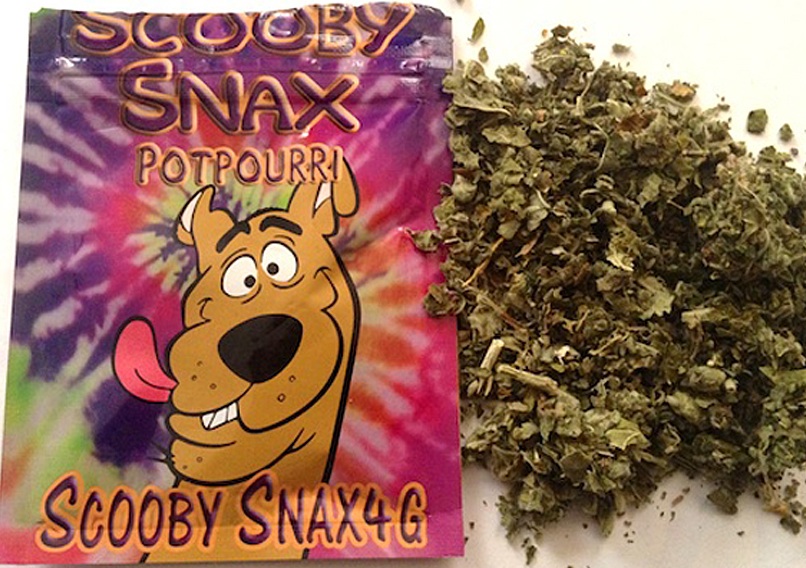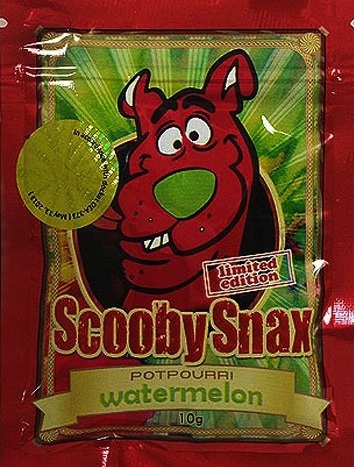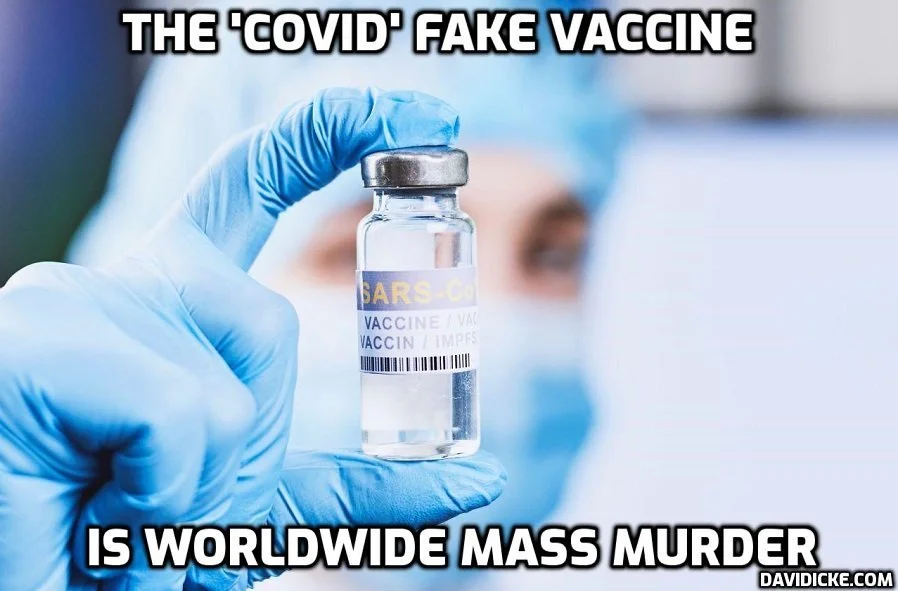The Image of Scooby Doo is being Used to Sell Deadly Synthetic Drugs to Black & Brown Kids. So Why has Warner Brothers/Hanna Barbera Done Nothing to Stop it?
/When Making a Business Decision the only "color" that matters is White. Simple and plain synthetic marijuana is nothing like marijuana. It is deception to even call it marijuana. It is deadly chemical shit to smoke that can destroy your brain or kill you. Its action in the brain may be similar to real marijuana but the physical effect to the brain are different.
Synthetic marijuana goes by hundreds of names: Spice, K-2, fake weed, Yucatan Fire, Bliss, Blaze, Skunk, Moon Rocks, and JWH-018, -073 (and other numerical suffixes). Synthetic cannabis, unlike pot, however, can cause a huge variety of symptoms, which can be severe: Agitation, vomiting, hallucination, paranoia, tremor, seizure, tachycardia, hypokalemia, chest pain, cardiac problems, stroke, kidney damage, acute psychosis, brain damage, and death.
 A popular brand is "Scooby Snax." It is sold using the image of cartoon character, Scooby Doo, undoubtedly without the blessing of Warner Brothers Animation/Hanna-Barbera, the animation studio that produced the cartoon and own all its rights.
A popular brand is "Scooby Snax." It is sold using the image of cartoon character, Scooby Doo, undoubtedly without the blessing of Warner Brothers Animation/Hanna-Barbera, the animation studio that produced the cartoon and own all its rights.
Scooby Snax are sold as a "potpourri product," with the disclaimer that it is not intended for human consumption. But it is synthetic "marijuana" smoked by users to get high - real high or a zombiefied high. The glossy packaging features a picture of a stoned looking Scooby Doo. The potpourri comes in the flavors, Watermelon, Green Apple, Blueberry Bliss, Strawberry Smash, Kush and others similar to the flavors available for blunts. There are no time or age restrictions on its sale and its cheap. And there is no need to special order it on the internet [like white kids do], in the Hood it is available at nearly every corner store, gas station or fine carry out establishment - many of these places are open 24 hrs. a day. Don't believe BW, go and see for yourself and then travel to a white neighborhood and see if you can find some.
Hanna Barbera are also makers of racist images, such as this genocidal cartoon above ridiculing Native Americans.
The powerful film company Warner Brothers/Hanna Barbera who made the children's cartoon Scooby Doo own all rights to the name and image of character. Nevertheless, Warner Brothers has done nothing to stop the company who manufactures [unknown? name is not on package!] and/or distributes Scooby Snax from using its copyrighted image. In other circumstances Hanna Barbera/Warner Brothers has acted to aggressively protect the image of Scooby Doo. For instance, in 2012 the company threatened to file a million dollar lawsuit against a small fish and chips restaurant [below] in London because it was named, "Fish & Chips, Scooby Snax." [MORE].
Cortly "C.D." Witherspoon, head of the local chapter of the Southern Christian Leadership Conference in Baltimore, considers a business that sells synthetic marijuana the equivalent of "a drug pusher." [MORE] So what does that make Warner Brothers/Hanna Barberra? For what reason would Warner Brothers do nothing to stop its mark from being used in a manner that is clearly harmful to the wholesome image of Scooby Doo and damaging to its value as a property interest? Who benefits?
To the extent that racist/white supremacists are involved in the sale and distribution of Scooby Snax such business obviously furthers the goal of maintaining white domination and the destruction of our youth and our communities. Scooby Snax potpouri has been sold since at least 2012. Stopping its powerful copyrighted image from being used to sell harmful drugs to non-white people clearly has not been a priority to Warner Brothers/Hanna Barberra. Stop supporting white supremacy. This means to boycott Warner Brothers/Hanna Barberra and its subsidiary companies, including New Line Cinema, Castle Rock Entertainment, TheWB.com, DC Entertainment and The CW Television Network until they do something to enforce their copyright and help shut this shit down. [info on the dangers below]
Synthetic weed is being marketed and targeted at young Black and Latino teens as a safe, legal high that is similar to real marijuana - but that is bullshit. Its name itself, "Synthetic marijuana" is deception and is also where the similarity ends. From [HERE] Researchers are starting to understand more about the drugs, and finding that synthetic cannabis is not even close to being the same drug as pot. Here’s what we know about what synthetic cannabis is doing to the brain, and why it can be deadly.
1. It’s much more efficient at binding and acting in the brain
One reason that synthetic cannabis can trigger everything from seizures to psychosis is how it acts in the brain. Like the active ingredient in pot, THC, synthetic cannabis binds the CB1 receptor. But when it binds, it acts as afull agonist, rather than a partial agonist, meaning that it can activate a CB1receptor on a brain cell with maximum efficacy, rather than only partially, as with THC. “The first rule of toxicology is, the dose makes the poison,” says Jeff Lapoint, MD, an emergency room doctor and medical toxicologist. “I drink a cup of water, and I’m fine. I drink gallons of it in some college contest, and I could have a seizure and die. Synthetic cannabinoids are tailor-made to hit cannabinoid receptors – and hit it hard. This is NOT marijuana. Its action in the brain may be similar but the physical effect is so different.”
Another issue with synthetic is its potency, which huge. “Its potency can be up to one hundred or more times greater than THC – that’s how much drug it takes to produce an effect,” says Paul Prather, PhD, professor of pharmacology and toxicology at the at University of Arkansas for Medical Sciences. “So it takes much less of them to produce maximal effects in the brain. So these things have higher efficacy and potency…These things are clearly very different from THC and thus not surprising that their use may result in development of life-threatening adverse effects.”
2. CB1 receptors are EVERYWHERE in the brain
A central reason that synthetic cannabis can produce such an enormous variety of side effects is likely because CB1 receptors are present in just about every brain region there is. When you have a strong-binding and long-lasting compound going to lots of different areas of the brain, you’re going to get some very bad effects.
Yasmin Hurd, PhD, Professor of Psychiatry, Pharmacology and Systems Therapeutics, and Neuroscience at Mount Sinai Medical Center, says that the wide distribution of CB1 receptors in the brain is exactly why they’re so toxic. “Where they’re located is important – their presence in the hippocampus would be behind their memory effects; their presence in seizure initiation areas in the temporal cortex is why they lead to seizures. And in the prefrontal cortex, this is probably why you see stronger psychosis with synthetic cannabinoids.” The cardiac, respiratory, and gastrointestinal effects probably come from the CB1 receptors in the brain stem. It might be any one of these that produces the greatest risk of death.
3. A synthetic cannabis overdose looks totally different from a pot “overdose”
The clearest proof that synthetic cannabis is a different thing all together is that overdose with the drug looks totally different from an “overdose” with natural marijuana. “Clinically, they just don’t look like people who smoke marijuana,” says Lewis Nelson, MD, at NYU’s Department of Emergency Medicine, Division of Medical Toxicology. “Pot users are usually interactive, mellow, funny. Everyone once in a while we see a bad trip with natural marijuana. But it goes away quickly. With people using synthetic, they look like people who are using amphetamines: they’re angry, sweaty, agitated.”
Whatever’s happening, he says, it may be more than just the replacement of THC with JWH. “It’s almost hard to imagine that it could be related to the partial vs. full agonist aspect of the drug.”
4. The body doesn’t know how to deactivate synthetic
One possibility is that the metabolites of synthetic cannabis are also doing damage to the brain. Usually our bodies deactivate a drug as it metabolizes it, but this may not be the case with synthetic. “What we’re finding from our research,” says Prather, “is that some of the metabolites of synthetic cannabis bind to the receptor just as well as the drug itself – this isn’t the case with THC. The synthetic metabolites seem to retain full activity relative to the parent compound. So the ability of our bodies to deactivate them may be decreased.”
He also points out that what’s lacking in synthetic cannabis is cannabidiol, which is present in natural marijuana and appears to blunt some of the adverse actions of the THC. But if it’s not there in synthetic cannabis, then this is one more way the drug’s toxicity may act unchecked. [MORE]










































































































































































































































































